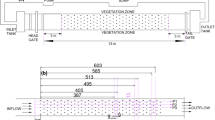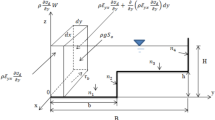Abstract
Incipient motion of sediment is one of the main aspects of the sedimentation process. Determination of the minimum shear stress or velocity required to initiate the motion of sediment particles is a crucial task in the rigid boundary drainage system design. This study investigates incipient motion through laboratory experiments conducted in trapezoidal, rectangular, circular, U-shape and V-bottom cross-section smooth channels using four different size-sands. Experimental data are analyzed using the shear stress and velocity approaches. Shields method is used in the shear stress approach while formulation proposed by Novak and Nalluri is used as the velocity approach. New relationships are proposed for computing shear stress and velocity required for incipient motion in each of the channels. Results are compared with the corresponding models available in the literature. Data collected in this study are found in an acceptable agreement with the existing models. Channel cross-section shape plays an important role in incipient motion of sediment. Among the channels, the rectangular and V-bottom channels require the lowest and the highest shear stress and velocity for the initiation of sediment motion, respectively.








Similar content being viewed by others
References
Ab Ghani A (1993) Sediment transport in sewers. PhD Thesis, University of Newcastle upon Tyne, UK
Ackers JC, Butler D, May RWP (1996) Design of sewers to control sediment problems. Construction Industry Research and Information Association (CIRIA), Rep. No. 141, London, pp 1–181
Al-Saqri T (1990) A study of shape effect on flow characteristics and incipient motion of sediment in rigid closed and open conduits. MSc Thesis, University of Newcastle upon Tyne, UK
Ambrose HH (1953) The transportation of sand in pipes free surface flow. In: Proceeding of the fifth hydraulic conference, Bulletin 34, State University of Iowa Studies in Engineering, Iowa State University, Iowa
Bong CHJ, Lau TL, Ab Ghani A (2013) Verification of equations for incipient motion studies for a rigid rectangular channel. Water Sci Technol 67(2):395–403
Bong CHJ, Lau TL, Ab Ghani A, Chan NW (2016) Sediment deposit thickness and its effect on critical velocity for incipient motion. Water Sci Technol 74(8):1876–1884
Butler D, May RWP, Ackers JC (1996) Sediment transport in sewers. Pt. 1: background. Proc Inst Civil Eng Marit Energy 118(2):103–112
Butler D, May R, Ackers J (2003) Self-cleansing sewer design based on sediment transport principles. J Hydraul Eng 129(4):276–282
Chiew YM, Parker G (1994) Incipient sediment motion on non-horizontal slopes. J Hydraul Res 32(5):649–660
Craven JP (1953) The transportation of sand in pipes—full pipe flow. In: Proceedings of the fifth hydraulics conference, Bulletin 34, State University of Iowa Studies in Engineering, Iowa State University, Iowa
Dey S (1999) Sediment threshold. Appl Math Model 23(5):399–417
Dey S (2003) Threshold of sediment motion on combined transverse and longitudinal sloping beds. J Hydraul Res 41(4):405–415
El-Zaemey AKS (1991) Sediment transport over deposited beds in sewers. PhD Thesis, University of Newcastle upon Tyne, UK
Ippen AT, Verma RP (1953) The motion of discrete particles along the bed of a turbulent stream. In: Proceedings of Minnesota International Convention, Minneapolise, MN
Kramer H (1935) Sand mixtures and sand movement in fluvial levels. Trans ASCE 100(1):798–838
Knight DW, Demetriou JD, Hamed ME (1984) Boundary shear in smooth rectangular channels. J Hydraul Eng 110(4):405–422
Lavelle JW, Mofjeld HO (1987) Do critical stresses for incipient motion and erosion really exist? J Hydraul Eng 113(3):370–385
Loveless JH (1992) Sediment transport in rigid boundary channels with particular reference to the condition of incipient deposition. PhD Thesis, University of London, UK
May RWP (1982) Sediment transport in sewers. Report No. IT 222, Hydraulic Research Station, Wallingford, UK
May RWP, Ackers JC, Butler D, John S (1996) Development of design methodology for self-cleansing sewers. Water Sci Technol 33(9):195–205
Mays LW (2001) Stormwater collection systems design handbook. McGraw-Hill, New York
Mohammadi M (1998) Resistance to flow and the ınfluence of boundary shear stress on sediment transport in rigid boundary channels. PhD Thesis, School of Civil Eng., Birmingham University, Birmingham, UK
Mohammadi M (2005) The initiation of sediment motion in fixed bed channels. Iran J Sci Technol B 29(B3):365–372
Nalluri C, Ab Ghani A, El-Zaemey AKS (1994) Sediment transport over deposited beds in sewers. Water Sci Technol 29(1–2):125–133
Nalluri C, Ab Ghani A (1996) Design options for self-cleansing storm sewers. Water Sci Technol 33(9):215–220
Novak P, Nalluri C (1975) Sediment transport in smooth fixed bed channels. J Hydraul Div ASCE 101(HY9):1139–1154
Novak P, Nalluri C (1984) Incipient motion of sediment particles over fixed beds. J Hydraul Res 22(3):181–197
Ota JJ (1999) Effect of particle size and gradation on sediment transport in storm sewers. PhD Thesis, University of Newcastle Upon Tyne, UK
Ota JJ, Nalluri C (2003) Urban storm sewer design: approach in consideration of sediments. J Hydraul Eng 129(4):291–297
Ota JJ, Perrusquia GS (2013) Particle velocity and sediment transport at the limit of deposition in sewers. Water Sci Technol 67(5):959–967
Paphitis D (2001) Sediment movement under unidirectional flows: an assessment of empirical threshold curves. Coast Eng 43(3):227–245
Paul TC, Sakhuja VS (1990) Why sediment deposit in lined channels. J Irrig Drain Eng ASCE 116(5):589–602
Pedroli R (1963) Bed load transportation in channels with fixed and smooth inverts. PhD Thesis, Scuola Politecnica Federale, Zurigo, Switzerland
Rouse H (1965) Critical analysis of open-channel resistance. J Hydraul Eng Div ASCE 91(4):1–23
Safari MJS (2016) Self-cleansing drainage system design by incipient motion and incipient deposition-based models. PhD Thesis, Institute of Science and Technology, Istanbul Technical University, Turkey
Safari MJS, Mohammadi M, Manafpour M (2011) Incipient motion and deposition of sediment in rigid boundary channels. In: Proceedings 15th international conference on transport & sedimentation of solid particles, 6-9 September, Wroclaw, Poland, pp 63–75
Safari MJS, Mohammadi M, Gilanizadehdizaj G (2013) Investigation on incipient deposition and incipient motion of sediment particles in rigid boundary channels. Water Soil Sci 23(3):3–25
Safari MJS, Mohammadi M, Gilanizadehdizaj G (2014) On the effect of cross sectional shape on incipient motion and deposition of sediments in fixed bed channels. J Hydrol Hydromech 62(1):75–81
Safari MJS, Aksoy H, Mohammadi M (2015) Incipient deposition of sediment in rigid boundary open channels. Environ Fluid Mech 15(5):1053–1068
Safari MJS, Aksoy H, Mohammadi M (2016) Artificial neural network and regression models for flow velocity at sediment incipient deposition. J Hydrol 541:1420–1429
Safari MJS, Aksoy H, Unal NE, Mohammadi M (2017) Non-deposition self-cleansing design criteria for drainage systems. J Hydro Environ Res 14:76–84
Shields A (1936) Application of similarity principles and turbulence research to bed-load movement. Preussiischen Research Institute of Hydraulic Engineering, Berlin, p 26
U.S. Army Engrs. Waterways Experiment Station (USAE-WES) (1936) Flume tests made to develop a synthetic sand which will not form ripples when used in movable bed models. Technical Memorandum 99-1, Viksburg, MS
Vanoni VA (2006) Sedimentation engineering. ASCE, Reston
Yen BC (2002) Open channel flow resistance. J Hydraul Eng 128(1):20–39
Acknowledgements
This study was supported by the Scientific and Technological Research Council of Turkey (TUBITAK) under the Project 114M283—Self-cleansing drainage system design by incipient motion and incipient deposition-based models. The study has also received partial support from the Scientific Research Projects Unit of Istanbul Technical University under the project 37973—Laboratory studies of sediment transport in rigid boundary channels.
Author information
Authors and Affiliations
Corresponding author
Rights and permissions
About this article
Cite this article
Safari, M.J.S., Aksoy, H., Unal, N.E. et al. Experimental analysis of sediment incipient motion in rigid boundary open channels. Environ Fluid Mech 17, 1281–1298 (2017). https://doi.org/10.1007/s10652-017-9550-z
Received:
Accepted:
Published:
Issue Date:
DOI: https://doi.org/10.1007/s10652-017-9550-z




